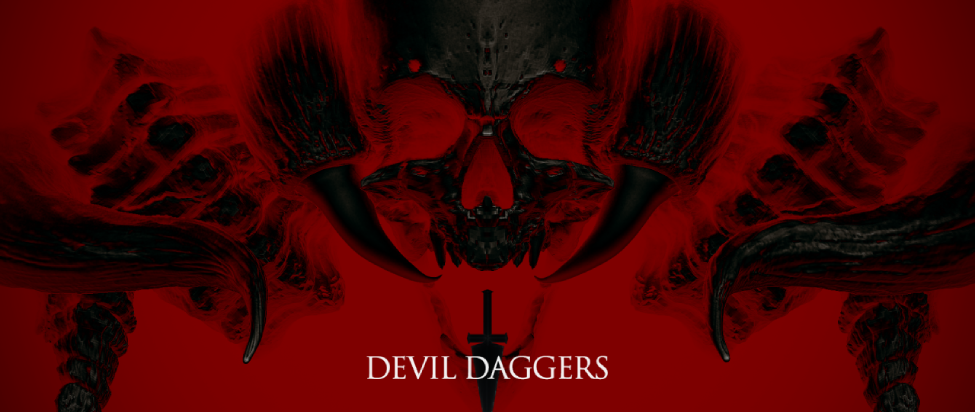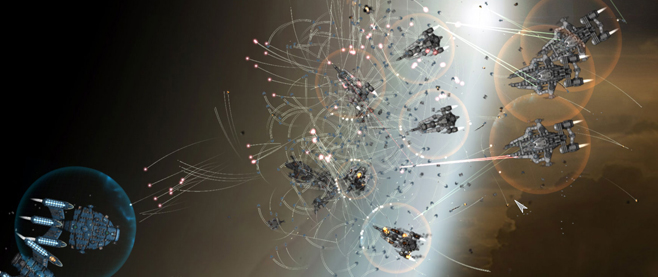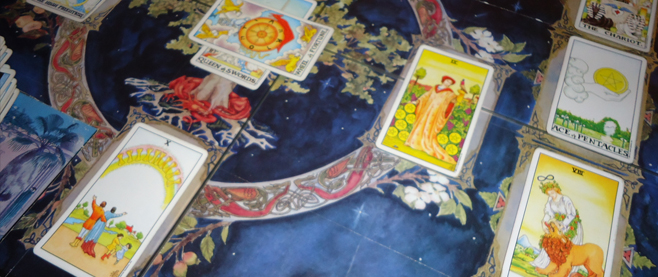
Have You Danced with Devil Daggers in the Pale Moonlight?
My relationship with Devil Daggers is perhaps best described as a performance. When I descend to its particular rendition of the underworld to dance with the Devil, weaving through hellspawn and collecting blood-red gems, the outside world dissolves around the edges of the screen. I can almost smell hot sulfur wafting from my laptop fans, feel the air singe my skin. I begin to hear what the game is telling me, to follow its orchestrated performance and step in tune. Within seconds, my luck will run out and the dance will end at the mercy of some chuckling skull. And yet as soon as I fall, I am stepping again, eager to kite the babbling hordes for another precious moment on the stage. Through a minimalist user interface and thoughtful repetition, Devil Daggers creates a performance so immersive that even Hell begins to feel like home.
Videogames commonly share a default layer of external, artificial elements that help translate the world of the game to the player enjoying it. For many games, this user interface is almost essential, acting as a means of abstraction to communicate why a mouse click or button-press produces the slash of a sword or opening of a door – these actions are inherently make-believe, and this extra layer allows us to better contextualize our interactions with an imaginary world. In this way, UI operates like the words on a page of a book: best at its least intrusive, allowing the inherent immersion of the story to sell itself.

Devil Daggers does an excellent job of minimizing, even eliminating external form all together – it’s all content, all immersive, nearly all of the time. Upon starting up the game, players encounter an intro screen with the title, and select “Play”. No on-screen icons or reticles are present. On death, they are greeted by a grinning leaderboard before immediately being placed back in another run. The fibrous connective tissue that often holds a game together is entirely gone. There is no contextual narrative, no meta-game advancement or tutorial prompts. It’s just the player and their hellish surroundings, again and again. When I am not able to rest my understanding of the game on the familiar ground of non-diegetic interface elements, something special occurs: The space becomes the interface. It is natural to immerse myself in the arena, to feel that the stone texture on the ground is actually not a texture but rough, cold, pockmarked granite, and the soft gleam that emanates from the camera is in fact a dutiful spotlight tracking my every move. Without the UI to explain and contextualize enemies, systems, and even the environment, I am forced to stop translating and rather start conversing with the game.
It’s around the 160-second mark of a run that my conversation with Devil Daggers begins to grow truly intimate. The polite greetings are out of the way, two spiders and a warbling centipede are annihilated in a sort of “chatting about the weather”-style introduction before the real topics of discussion are dialed in, and my gem collection has started to near the required size for an important mid-game upgrade. It’s also around this time that the number and strength of my sulfuric opponents grows significantly. Skulls swarm in thick droves and tentacled spawners clog the already-thinning lanes of navigable space. During these hectic moments, the seconds-that-feel-like-eons leading to a gem upgrade, Devil Daggers makes me feel like I can dance.
The world around me ceases to exist, distractions singing into ash and worries exploding into the bloody shrapnel of an eradicated skull horde. As centipedes swirl overhead and parasites swarm cracked stone tiles, the spotlight is lowered and the curtains are yanked open. I and the game stop translating and start speaking, a symbiotic harmony formed out of bunnyhops and split-second sniper shots.The intensity of this experience is bolstered even further when I receive the final needed gem and get a projectile upgrade. A screech hisses through the air like hot steam as my frantic surroundings enter slow-motion, my arm shimmers and pulses with the colors of a rainbow, and I unleash hell upon its own poor denizens.

Even in this state of symbiosis, my opposition is unrelenting, and I will assuredly die soon. But when it occurs, and I am forcibly ripped off the stage and placed back on my couch, I will understand Devil Daggers a little better. Our conversation grows a bit deeper, in the most minute and seemingly meaningless fashion. But over the course of dozens, hundreds, thousands of runs, these small ripples become large waves, and I develop almost a sixth-sense for the physical space of the game-world. Unlike most run-based titles, Devil Daggers is not randomized in any way. The same enemies will always spawn in the same place at the same time. And so each run, I delve myself into hell as long as I can handle before emerging back at the surface, arms full of new touch-memory and spatial understanding. I become aware of how long a laughing skull can remain off-screen before its putrid breath will be felt on my back, the ideal order to target enemies at second 56, and how many gems I should have by second 143. In this way, playing Devil Daggers is like putting on a theatrical performance. Whereas other games may put the player in a minor supporting role, or even that of an audience member, here I am the star of the show. The stage is lit, the choreography is defined, and my fellow actors are waiting behind the curtain. All I need to do is step in tune.
In the same fashion that old friends might take pride in knowing the most intimate details and secret qualities of one another, I take pride in understanding this game inside and out. Call it a conversation or a performance of something else entirely – the fact remains that an intimately immersive relationship is formed through the use of minimalist UI and painstaking repetition. In spite of its vicious intensity and cruel aesthetic, Devil Daggers is kind enough to let the song of my muscles take control, to flow over hard stone like cool water – to dance among the damned. And when the Devil takes me to hell for my sharp edges, I know that I will feel at home on the stage.
———
Hayes is studying game design and technical art at the University of Utah. You can find more of his ramblings here.





